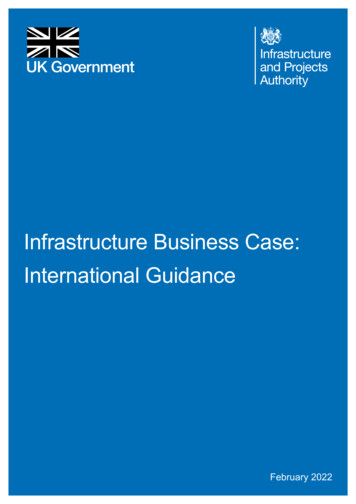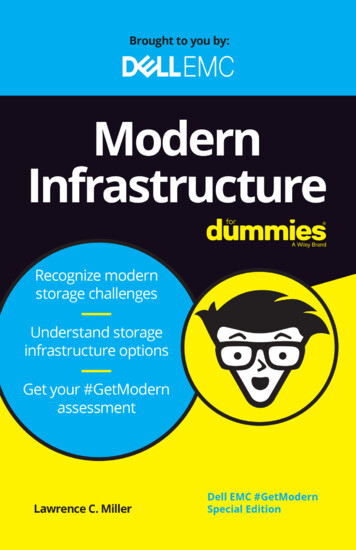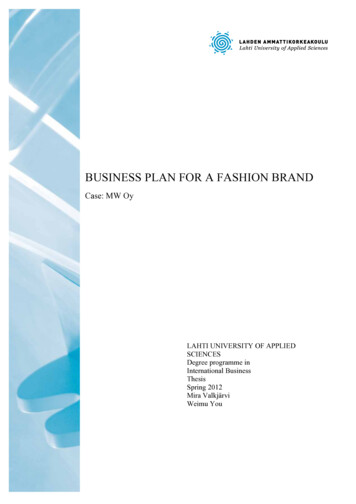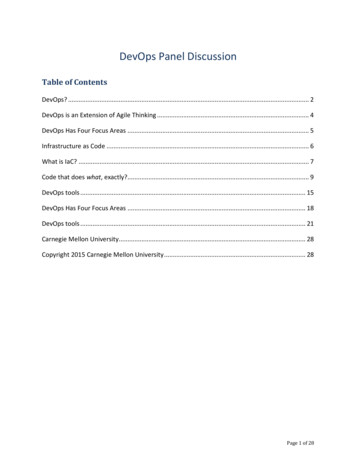
Transcription
Annex 1Infrastructure Business Case:International Case StudyFebruary 2022
This second edition replaces the original July 2020 edition. Crown copyright 2022Produced by the Infrastructure and Projects AuthorityYou may re-use this information (excluding logos) free of charge in any format or medium,under the terms of the Open Government Licence. To view this licence,visit ment-licence/or email: psi@nationalarchives.gsi.gov.ukWhere we have identified any third party copyright material you will need to obtainpermission from the copyright holders concerned.Any enquiries regarding this publication may be sent to us by e mail at IPA@ipa.gov.uk
ContentsForeword and Purpose 1Background 201. Strategic Case 61.1Introduction 71.2Project Rationale and Strategic Context 81.3 Determine Objectives, Existing Arrangements and Strategic Need 181.4Define Potential scope 331.5 Describe Benefits, Risks, Constraints and Dependencies 3802. Economic Case 522.1Introduction 532.2Define Critical success factors 542.3 Apply “options framework” to create a wide range of options and refine it to a shortlist of possible options 552.4 Conduct Cost Benefit Analysis and Establish Preferred Option 692.5Determine Non-Monetised Risks and Benefits 852.6Conduct Sensitivity Analysis 852.7 Review Environmental and Social Impact Assessments (ESIA) 862.8Conclusion 872.9Value for money of private finance 8703. Commercial Case 923.1Introduction 933.2Determine the Commercial and Procurement Strategies 943.3 Outline the Base Specification, Potential Service Streams and Outputs 1003.4Allocate the Risks 1043.5Develop the Payment Mechanisms 1083.6Identify Key Contractual Issues 1113.7Working with the Multilateral Development Banks 114Infrastructure Business Case: International Case Study iii
04. Financial Case 1164.1Estimate Costings and Benchmarking 1174.2Estimate Revenues / Income 1204.3Identify Financing Sources 1224.4Build Financial Models 1234.5Assess Impact on the Council’s Own Income and Expenditure Account 12505. Management Case 1305.1Introduction 1315.2Prepare Project Management structure and Governance / Reporting arrangements 1325.3Describe Use of Advisers 1355.4Devise Project Plan 1365.5 Devise Stakeholder and Change Management arrangements 1395.6Prepare Benefits Realisation Strategy and Plans 1445.7Prepare Risk Management Strategy and Plans 14806. Schedule 1 – Glossary iv Infrastructure Business Case: International Case Study149
Figure ReferencesFigure 1 – Map of Nirvana 3Figure 2 – Map of Elisia and current transport position 34Figure 3 – Core coverage (minimum) 34Figure 4 – Desirable coverage (proposed) 35Figure 5 – Optional coverage (maximum) 35Figure 6 – Cover areas 36Figure 7 – Options Framework “filter” 56Figure 8 – NPV of PSC vs PPP 89Figure 9 – Project Management Team 134Figure 10 – Approvals and Assurance Stages 138Table ReferencesTable 1 – Socio-demographic statistics 10Table 2 – National Policy Drivers 13Table 3 – Regional Policy drivers 14Table 4 – Local Policy Drivers – City Transport Plan 15Table 5 – Project and the CTP 16Table 6 – Project Objective (Where you want to be) and SMART Outputs (Measures) 19Table 7 – Objectives 21Table 8 – Bus journey times – peak vs off-peak 24Table 9 – Bus ridership by time of day 25Table 10 – Bus network related assaults 26Table 11 – Business needs – Problems 27Table 12 – Business needs – Opportunities 31Table 13 – Route Scope 37Table 14 – Summary of Benefits 39Table 15 – Linking Benefits to Strategic Priorities 41Table 16 – High-level risks and their mitigation measures 42Table 17 – Developing options for each dimension 57Table 18 – Matrix used describing a wide range of options 66Table 19 – Short-list of options assessed against CSFs 68Table 20 – Capital Costs Summary 71Table 21 – 60 year operating costs 72Table 22 – Capital costs (real – total over 60 years) – preferred option 75Table 23 – Operating costs (real – total over 60 years) – preferred option 76Infrastructure Business Case: International Case Study v
Table 24 – Present Value Costs 77Table 25 – Values of Time 78Table 26 – Monetisation of accident savings 79Table 27 – Distributional Impacts of User Benefits 80Table 28 – Analysis of Monetised Costs and Benefits for the preferred option (option 4) 84Table 29 – Summary of Public Value and BCRs 85Table 30 – Sensitivities 86Table 31 – Risk allocation matrix 104Table 32 – Risk Transfer 113Table 33 – Capital costs (nominal – total over 25 years) 119Table 34 – Operating costs (nominal – total over 25 years) 119Table 35 – Estimated revenues/income (Years 4 – 10) 121Table 36 – Cumulative cash flows under PPP 126Table 37 – Cumulative cash flows under traditional procurement (base position) 127Table 38 – Cumulative cash flows under traditional procurement (sensitivities) 128Table 39 – List of lead advisers 135Table 40 – Key project milestones 136Table 41 – Project Roles & Descriptions 154vi Infrastructure Business Case: International Case Study
Infrastructure Business Case: International Case Study vii
Foreword and PurposeThe Infrastructure and Projects Authority (“IPA”) is pleased to present this model CaseStudy which illustrates how a business case for an infrastructure project, at IntermediateBusiness Case stage, could look.It forms part of a suite of products including:o IPA’s Infrastructure Business Case: International Guidance (the “Guidance”);o Workshops – see Schedule 2 of the Guidance, ando On-line training materials (see Annex 3 of the Guidance).It is designed to be read alongside the Guidance – to illustrate the various actions neededto develop a business case using the 5 Case Model approach. References to Actions are tothe 45 Actions set out in the Guidance.WarningThe subject of this Case Study is a fictitious light rail project in a fictitious country.It is not intended to cover every aspect of a real business case or to replicate thesignificant work that would go into preparing a large-scale project. Its purposeis to help the reader think critically and creatively about drafting his or her ownbusiness case.Financial details are not intended to approximate actual costs and are not directlylinked to the indicative costs given in the Economic Case. It is designed purely forillustrative purposes; “[xxx]” shows areas and data that would need to be included in acomplete business case.A fictional currency of Nirvanian Lira (NL ) is used to represent the figures in both theEconomic and Financial Cases.Each country and each project will have its own particular requirements, and each willbe different – but this Case Study should provide a useful learning guide for all.Key learning points from this Case Study are signposted in text boxes in the Guidance.Footnotes in this Case study refer you to corresponding text in the Guidance.This Case Study uses the same terms as the Guidance (and these are defined inSchedule 1 of the Guidance).1 Infrastructure Business Case: International Case Study
BackgroundNirvana“Nirvana” is a stable country with Gross Domestic Product well above average, comparedto its neighbours. It has a diverse industrial base and sustainable levels of debt. Thereare however significant disparities between the wealthy and industrialised North and therelatively deprived agricultural Southern part of the country.A National Infrastructure StrategyIn 2016, in order to improve the competitiveness of the country and reduce regionaldisparities, the central government published “Investing in Infrastructure Strategy 20182023”, as its six-year National Infrastructure Strategy setting out its priorities across anumber of sectors, including transport.The Role of TransportAt a high-level central government seeks to:o reduce transport congestion and improve the reliability of journey times to ensurethat congestion does not restrict economic activity;o improve transport connectivity and integration between regional and nationalnetworks across the country to ensure more efficient travel;o improve access to employment and learning to help people into work, boostemployment and increase the number and range of learning opportunities;o improve accessibility to key services, such as healthcare, to ensure that people haveaccess to the services they need;o reduce the impact on the environment and greenhouse gas emissions from thetransport sector; ando increase levels of health and activity by improving transport infrastructure forpedestrians and cyclists.Infrastructure Business Case: International Case Study 2
Figure 1 – Map of NirvanaCapital CityHadesRegion:ElisiaRegion’smain city:OlympusElisiaThe region of Elisia lies in the centre of Nirvana. It borders agricultural regions to theWest, East and South, with the country’s industrialised base lying to the North. It containsone major city, Olympus (which is the second largest city in Nirvana) and a number ofsmaller, but rapidly growing, towns and villages.OlympusOlympus is seen as a success. Despite its location (in the South of the country), ithas managed to overcome its historic disadvantages. Over the last two decades, itspopulation has boomed, driven, most recently, by a series of successful governmentpolicies aimed at strengthening existing industries and attracting large foreigncompanies in order to establish new industry.The success of these industries has provided employment opportunities andunemployment levels, although higher than desirable, have fallen. Labour has flowedin from smaller towns, mainly from neighbouring less developed regions, but also fromneighbouring countries. Gross Domestic Product has increased at a higher rate than thenational average, but still falls short of that of Hades, the capital, towards which vastamounts of resources and investment are directed.Local Constraints to GrowthDespite this success, Olympus is facing a number of problems not uncommon in rapidlyurbanising areas. Housing shortages and affordability issues in the centre are forcingindividuals to move further out of the city.3 Infrastructure Business Case: International Case Study
This makes the road network – used by private and commercial vehicles, buses andvarious non-mechanised forms of transport including bicycles – congested and unsafe.Road-related accidents and deaths have reached an all-time high while illnesses, causedby increasing pollution, are rising. Travel times have increased so much that it is no longerfeasible for some parts of the population to reach jobs in the city centre, which is wherethe majority of employers are located. As a result, despite the increase in city’s wealth,unemployment in the region is still above target (with poverty still widespread). This gap ininfrastructure is having a disproportionate effect on the poor and marginalised of society.In addition to these transport issues, it suffers from:o geographical segregation;o differences in educational attainment;o poor access to job opportunities;o income inequalities between people of different ethnicities and religiousaffiliations; ando low female work-force participation.Public institutions have failed to keep up with the rapid economic growth, with allegationsof corruption and overly bureaucratic processes. Small and medium-sized enterprisessuffer especially.In Search of Local SolutionsThe Olympus council, funded partly through local taxes and partly through grants fromcentral government, is seeking to implement solutions aimed at alleviating these issuesand stimulating growth. An independent economic review has been commissioned,which has made various recommendations for dealing with these issues. These includeincreasing housing provision, improving access to education, enhancing the skills of theworkforce through vocational training, investing in crime prevention measures, improvingair quality and reducing road congestion.Subsequent to this review, the Olympus council commissioned a Local Development Planbuilding on the National Infrastructure Strategy. As regards transport, the plan makes thefollowing recommendations:o increase the scope and size of the public transport provision;o ease road congestion by encouraging walking and cycling, both through educationalprogrammes and specific road measures (such as cycling lanes and safewalking routes);o work with neighbouring cities to improve inter-city transport links;o increase the size of the labour market by increasing the number of people able toaccess jobs across the city;o increase access to work for those in the lower income quartile;o reduce the contribution to national greenhouse gas emissions from transport; andInfrastructure Business Case: International Case Study 4
o improve the quality of life for local inhabitants, particularly in relation to travelconditions (safety, ease and comfort) and pollution (air quality).One specific recommendation relates to the provision of some form of mass rapidtransportation for the city. Initial studies carried out by the Nirvana national transportpolicy body, as well as a political desire to bring the city on par with major cities on thecontinent, point to a light rail system as being one of the more appropriate solutions,subject to detailed feasibility studies to be carried out by Elisia. Accordingly, the Olympuscouncil prepared an Early Business Case, which was approved by the central governmentthree months ago. The Early Business Case had a well-developed strategic case that laidout the need for a public transport solution for the city and the region, and the processfollowed in order to short-list the various options available. Of these shortlisted optionsan Environmental and Social Impact Assessment (ESIA) was carried out for each ofthem, in order to identify and evaluate the environmental and social risks and impactsof the options. In addition, the Early Business Case contained a high-level economicand financial analysis giving an initial indication of the feasibility of the project. Centralgovernment gave its approval for Olympus to develop an Intermediate Business Case forthe project, in order to:o review the short list of options and subject them to cost benefit analysis, assessingpotential value for money;o review the ESIA studies that were carried out at Early Business Case stage;o consider in detail the affordability and commercial viability of the project; ando identify the expected resources and management arrangements and how the projectwould be procured.This Intermediate Business Case is set out in the following chapters.5 Infrastructure Business Case: International Case Study
01StrategicCase
Strategic Case1.1 01IntroductionThe Strategic Case covers the rationale for the project1, its scope and objectives, andplaces it within an overall strategic and policy context.This proposal has been identified as a key part of the City Centre Transport Programme(“CCTP”). It is also set in the context of existing local, regional and national infrastructureand development plans, and aims to contribute to the continued development of Olympusas an attractive place to live and work.Olympus suffers from:o congested roads which are leading to ever longer travel times for both carand bus users;o poor public transport – exclusively served by buses which do not serve the needs ofan expanding and modern economy, and is particularly impacting upon the poor andmarginalised in the society;o aging public and private vehicles – heavily polluting diesel bus fleet and no regulationon private car emissions;o a badly connected public transport system with few inter-city transport links; ando roads unsafe for cyclists and users of other non-motorised transport.The proposed project involves developing a solution to:o ease congestion, increase affordable public transport provision, and replace vehicleswith low emission fleet;o serve the transport needs of Olympus equally across the rapidly growing population,and improve accessibility and safety for women, disabled, poor, and othermarginalised groups;o increase connectivity across the city’s extended suburbs so as to enable agreater amount of the population to access places of work, education and retailopportunity; ando contribute to the continued development of Olympus as an attractive place tolive and work.1As explained in Section 3: Business Case Development Process of the International Infrastructure Guidance, the 5-case model can beused for policies and strategies, for programmes (where a programme business case can outline the overall strategy and programmebudget for inter-related projects), and for projects. The Guidance is principally focused on the requirements of the project businesscase.7 Infrastructure Business Case: International Case Study
The creation of a modern light rail public transport system fit for the 21st Century is a keyproject within the CCTP and plays a key role in the local transport plan whilst supportingthe wider regional and national strategies.The Strategic Case should be:o broadly developed at Early Business Case stage2;o largely complete at Intermediate Business Case stage3; ando revisited and updated as required at Final Business Case stage4.1.2 Project Rationale and Strategic ContextConcise Statement of what the Project is and what it aims to achieveThe proposed project involves the design, construction, operation and maintenance of alight rail scheme to serve the transport needs of Olympus’s rapidly growing population. Aconcise description of what the project is and what it aims to achieve is summarised inthe box below:See Actions 1-4 in the Guidance for more detailSee Action 12 in the Guidance for more detail4In the UK and the Better Business Case standard, these iterations are called: Strategic Outline Case, Outline Business Case, and FullBusiness Case, respectively. In New Zealand, which has also adopted the model, they are called: Indicative Business Case, DetailedBusiness Case, and Procurement Business Case, respectively. The precise names chosen for these versions are not important – thethree-staged iterative approach however is.23Infrastructure Business Case: International Case Study 8Strategic CaseThe Early Business Case considered a wide range of transport options, includingvarious forms of bus, guided bus, light rail, tram and underground. Four light rail optionswere shortlisted for further appraisal at this Intermediate Business Case stage. TheCouncil commissioned technical, environmental, and traffic forecast reports thatconfirmed the feasibility of this approach. The process of short-listing these options isre-produced in this Economic Case. These include the design, construction, operationand maintenance of a light rail scheme to serve the transport needs of Olympus’s rapidlygrowing population.
What the Project isWhat it aims to achieve (at a high level only)The proposed projectinvolves the design,construction, operationand maintenance ofan urban mass transitlight rail transportsystem (the “Project”).It aims to:o ease congestion and increase affordable publictransport provision;o serve the transport needs of Olympus equallyacross a rapidly growing population and urbanisedarea, with provision for the needs of all user groupsincluding women and persons with disabilities;o reduce the transport sector’s contribution tonational greenhouse gas emissions by upgradingpublic vehicles;o increase connectivity across Olympus’ extendedsuburbs to enable more of the population toaccess places of work, education and retailopportunity; ando contribute to the continued development ofOlympus as an attractive place to live and work5This requirement has been brought about by the following problems with the currenttransport system:o congested roads which are leading to increasingly longer travel times for both carand bus users;o a poor public transport offering – exclusively served by buses which do not serve theneed of an expanding and modern economy, and is particularly affecting women, thepoor, and marginalised groups in the society;o aging public and private vehicles – heavily polluting diesel bus fleet and no regulationon private car emissions;o a badly connected public transport system with few inter-city transport links; ando roads which are unsafe for cyclists and users of other non-motorised transport.At Early Business Case stage, a wide range of transport options were consideredincluding various forms of bus, guided bus, light rail, tram and underground – and fourlight rail options were shortlisted for further appraisal at this Intermediate BusinessCase stage. The Council commissioned technical and traffic forecast reports whichconfirmed the feasibility of this approach. Environmental and Social Impact Assessmentswere conducted for each of the shortlisted options; the review of these reports will beconducted in the Economic Case of this Intermediate Business Case.The creation of a modern light rail public transport system fit for the 21st Century forOlympus will play a key role in the local transport plan and supports the wider regional andnational strategies.5See Action 1 of the Guidance.9 Infrastructure Business Case: International Case Study
Strategic CaseStrategic ContextThe proposed Project is set in the context of existing national, regional and localinfrastructure and development plans as explained below.Nirvana is also committed to contribute towards international goals, and everypublic infrastructure project needs to align with those objectives; specifically the UNSustainable Development Goals (SDGs) and the Paris Agreement on Climate Change.Socio-economic OverviewThe region of Elisia contains the fourth largest developed urban area in the country, withan area of some 115 square kilometres, but the second largest in terms of population (thecapital Hades’ region being the largest).The history of the region has made it one of the most important areas in Nirvana being atthe core of the country’s industrial development. The decline of local mining industriesover decades however has led to an increase in social deprivation and unemployment.Recent years have seen a revival in Elisia’s fortunes, with the arrival of new industriesand increased levels of tourism. There is therefore a desire, and an increasing need, toimprove connectivity to drive this increased activity further, while also addressing theunemployment and deprivation problems.Table 1 – Socio-demographic statisticsCity 00,0002,800,000530,000225,000210,000190,000Area (km2)242,4951,5721,276115182219Pop. opulationwith ,0001,781,100340,000142,000132,000120,460Average income(per mploymentrate (%)4.20%5.0%5.5%7%8%9%8%Working agepopulationTown BTown CTown DInfrastructure Business Case: International Case Study 10
Employed inmanagerial/professionalcapacity (%)NirvanaHadesElisiaCity A:OlympusTown BTown CTown D42%53%32%41%17%11%14%The population is predicted to grow at an annual rate of 3% over the next decade throughinward immigration to fill new jobs.At the time of the census, the areas in which the proposed transportation schemewould operate had unemployment levels significantly above the national average. Thepercentage of residents employed in a professional capacity is well below the nationalaverage in areas outside of the city centre, while it is equal to the average in the moreaffluent neighbourhoods (including the city centre). Overall, there is high level ofemployees in lower grade jobs – generally a reflection of poor educational attainment.Town C has the highest percentage of population with no or low qualifications, higherthan both the regional and national averages.DeprivationThe National Statistics Office publishes “Indices of Deprivation” which provide a set ofrelative measures of deprivation for areas across the country. This is based on sevenaspects of deprivation which are combined to produce the overall “Index of MultipleDeprivation”, namely:o Income Deprivation;o Employment Deprivation;o Education, Skills and Training Deprivation;o Health Deprivation and Disability;o Crime;o Barriers to Housing and Services; ando Living Environment Deprivation.These statistics show that the region contains some of the most deprived areas in thecountry, many within the lowest 5%.Unemployment and IncomeWith a population of 2.8m, Elisia has an unemployment rate of 5.5% compared to thenational unemployment rate of 4.2%. In some areas, the unemployment is as high as 9%.Latest statistics indicate that the average annual income for Elisia is around NL 20,700This is almost 13% below the national average of NL 23,750.11 Infrastructure Business Case: International Case Study
Strategic CaseEmployment LocationsThe main employment opportunities are located in the City centre, where a numberof businesses, predominantly in the high value-added services sector, are located.These include Information Technology, Financial Services and Consultancy, as well ashigh-end retail.The two major towns in the region, noted in Table 1 above, also serve some of the largerpopulation centres, both having their own areas of specialisation. Town A attracts asignificant amount of tourism due to the presence of wildlife and scenic locations. It isserved by a rail link to Hades.Town B is industrial, where the presence of copper mines, an important export, continuesto provide employment and where new methods of extraction have recently improvedproduction levels. It is served by rail freight links to the West and East of Nirvana.Towns C & D are similar rural, agricultural towns that suffer from high levels ofunemployment (trending well above the national average), along with high percentages ofresidents with no qualifications. Existing transportation links consist of the regional roadnetwork alone.Economic GrowthIn addition to supporting a broad range of national and regional objectives, the proposedlight rail scheme is a crucial catalyst in fostering economic growth. It should enable thearea to achieve economic prosperity, attract businesses and increase opportunities forthose on lower incomes, particularly certain ethnic and religious minorities as well as thefemale population who are under-represented in the work-place. The scheme will improveaccess to the employment opportunities across the wider region ensuring the deprivedareas that surround the line can access the job opportunities in the expanding districts.A range of key policy drivers are relevant to this investment at national and regional levelsand are shown in the sections below.International GoalsThe country of Nirvana has committed to reducing greenhouse gas emissions in line withthe Paris Agreement on Climate Change, and has developed their Nationally DeterminedContributions (NDCs) required for meeting these commitments. Each sector of theeconomy must actively work to decarbonise infrastructure assets and operations tocontribute towards these objectives.Nirvana has also endorsed the Sustainable Development Goals (SDGs), and is collectingdata against SDG indicators to report progress at a national level. Projects andgovernment departments should record and collate data annually to submit to the centralauthority responsible for reporting.National Policy DriversThe National Policy drivers are set out below.Infrastructure Business Case: International Case Study 12
Table 2 – National Policy DriversPolicy Driver6Main targets of policyEmployment strategyo Reduce the rate of unemploymento Reduce the dependence of employment on certaineconomic sectorso Increase female participation rateo Increase participation rates of persons with disabilities,minority, and under-represented groupso Increase access to jobs for people living outsidethe core citiesGDP action plano Increase overall growth rate of GDPo Achieve a more geographically balanced growth in GDPo Achieve a more sector-balanced growth in GDPProductivity policyo Improve access to job opportunitieso Improve infrastructure to attract greaterprivate investmento Improve the regulatory environmentRegeneration strategyo Improve the living environment of citieso Develop brownfield sites containingdilapidated buildingso Improve transport access to areas in need ofregenerationo Develop infrastructure that is resilient toclimate changeGreen Standards Reviewo Reduce dependency on fossil fuelso Reduce emissions in heavily populated areaso Remediate areas of contamination, and restore andenhance natural habitat on public landRegional Policy DriversThe Regional Authority has developed a Regional Development Strategy, which is builtaround a vision for Elisia as an attractive place to live and work, with the RegionalAuthority playing a central role in addressing key challenges. From a transportperspective, the authority believes in delivering value to local taxpayers through excellent,but affordable, public services and serving communities across the whole region.6Ideally, this list should summarise government reference documents.13 Infrastructure Business Case: International Case Study
The Regional Development Strategy has five key objectives as stated below.Table 3 – Regional Policy driversRegional Policy DriverDescriptionConnectivity andAccessibilityo Help people to travel across the Region more easily,and to be able to access employment opportunities andall the services they need. Tackle congestion on theRegion’s transport networks, particularly by increasingpublic transport provisionEmployment andEducationo Increase the proportion of people in employmentand increase the number and range of learningopportunitiesHealth and Wellbeingo Improve the health and wellbeing of people in theregion, particularly women and persons with disabilitiesSafetyo Improve the safety of people and communities, andreduce the number of deaths a
1Infrastructure Business Case: International Case Study Forward and Purpose The Infrastructure and Projects Authority (“IPA”) is pleased to present this model Case Study which illustrates how a business case for an infrastructure project, at Intermediate Business Case stage, co










